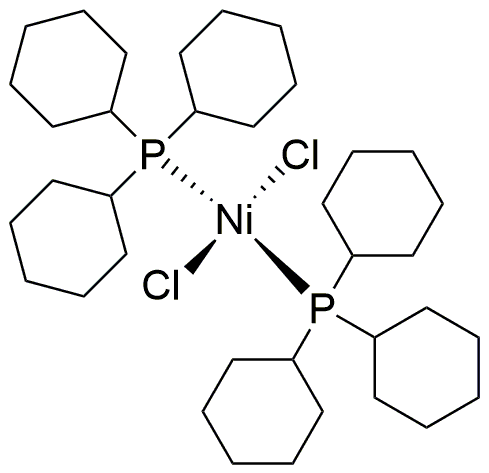Bis(tricyclohexylphosphine)nickel(II) dichloride is widely utilized in research focused on:
- Catalysis: This compound serves as an effective catalyst in various organic reactions, particularly in cross-coupling reactions like Suzuki and Heck reactions, which are essential in the synthesis of pharmaceuticals and agrochemicals.
- Material Science: It plays a crucial role in the development of advanced materials, including polymers and nanomaterials, enhancing properties such as durability and thermal stability.
- Electrochemistry: The compound is used in electrochemical applications, including the development of batteries and fuel cells, where it can improve conductivity and efficiency.
- Environmental Chemistry: It is employed in processes aimed at pollutant degradation and remediation, helping to develop cleaner technologies for waste management.
- Research and Development: In academic and industrial laboratories, it is a valuable reagent for synthesizing new nickel complexes, aiding in the exploration of novel catalytic pathways and mechanisms.
General Information
Properties
Safety and Regulations
Applications
Bis(tricyclohexylphosphine)nickel(II) dichloride is widely utilized in research focused on:
- Catalysis: This compound serves as an effective catalyst in various organic reactions, particularly in cross-coupling reactions like Suzuki and Heck reactions, which are essential in the synthesis of pharmaceuticals and agrochemicals.
- Material Science: It plays a crucial role in the development of advanced materials, including polymers and nanomaterials, enhancing properties such as durability and thermal stability.
- Electrochemistry: The compound is used in electrochemical applications, including the development of batteries and fuel cells, where it can improve conductivity and efficiency.
- Environmental Chemistry: It is employed in processes aimed at pollutant degradation and remediation, helping to develop cleaner technologies for waste management.
- Research and Development: In academic and industrial laboratories, it is a valuable reagent for synthesizing new nickel complexes, aiding in the exploration of novel catalytic pathways and mechanisms.
Documents
Safety Data Sheets (SDS)
The SDS provides comprehensive safety information on handling, storage, and disposal of the product.
Product Specification (PS)
The PS provides a comprehensive breakdown of the product’s properties, including chemical composition, physical state, purity, and storage requirements. It also details acceptable quality ranges and the product's intended applications.
Certificates of Analysis (COA)
Search for Certificates of Analysis (COA) by entering the products Lot Number. Lot and Batch Numbers can be found on a product’s label following the words ‘Lot’ or ‘Batch’.
Numéro de catalogue
Numéro de lot/série
Certificates Of Origin (COO)
This COO confirms the country where the product was manufactured, and also details the materials and components used in it and whether it is derived from natural, synthetic, or other specific sources. This certificate may be required for customs, trade, and regulatory compliance.
Numéro de catalogue
Numéro de lot/série
Safety Data Sheets (SDS)
The SDS provides comprehensive safety information on handling, storage, and disposal of the product.
DownloadProduct Specification (PS)
The PS provides a comprehensive breakdown of the product’s properties, including chemical composition, physical state, purity, and storage requirements. It also details acceptable quality ranges and the product's intended applications.
DownloadCertificates of Analysis (COA)
Search for Certificates of Analysis (COA) by entering the products Lot Number. Lot and Batch Numbers can be found on a product’s label following the words ‘Lot’ or ‘Batch’.
Numéro de catalogue
Numéro de lot/série
Certificates Of Origin (COO)
This COO confirms the country where the product was manufactured, and also details the materials and components used in it and whether it is derived from natural, synthetic, or other specific sources. This certificate may be required for customs, trade, and regulatory compliance.


